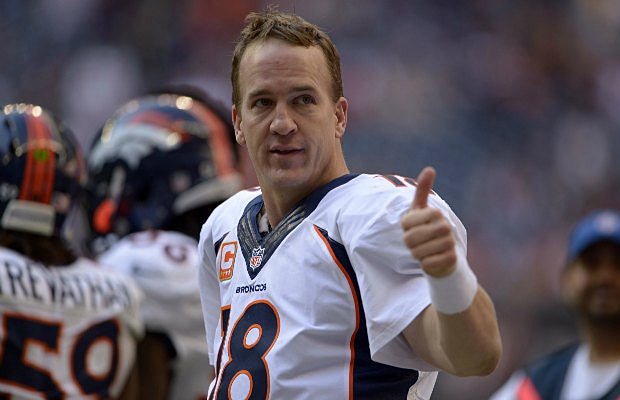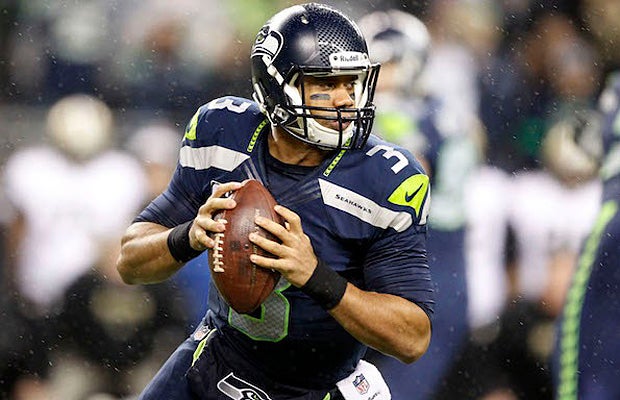The four remaining starting quarterbacks in the NFL playoffs are show-stoppers, game-changers, media megastars, and even icons.
Denver's Peyton Manning and New England's Tom Brady are playing for historical legacy honors — perhaps the greatest quarterbacks of their era — in the AFC championship game.
Seattle's Russell Wilson and San Francisco's Colin Kaepernick are vying for top budding super-QB status along with the NFC championship.
But how were these gents as preps? How would we rate them? Well, one was a definite blue-chip, five-star recruit. The others all fit under the term, "chancy."
Maybe that's because the three marginal college football prospects were all baseball stars and the 5-star football prospect played only one sport.
Needless to say, all emerged into football stardom.
Here's how we would rank them based on their high school careers.
No. 1 — Peyton Manning
Peyton Manning was one of the most highly recruited players in the country in his high school days.
USATSI
Manning was the Gatorade National Player of the Year while starring at Isidore
Newman (New Orleans), where he started as a sophomore in 1991. Following in the footsteps not only of his NFL All-Pro quarterback dad Archie, but also his older brother Cooper, Manning threw 23 touchdown passes as a sophomore, many of them to his brother. Over the next two seasons Peyton threw for 69 touchdowns and was one of the top five recruits in the country. His recruiting process was well documented and heated, as he finally chose Tennessee over Michigan, Florida State, Notre Dame and Mississippi.
No. 2 — Russell Wilson
Russell Wilson was a three-sport star for Collegiate High School.
USATSI
Despite his lack of height and playing at a prep school —
Collegiate (Richmond, Va.) — the 5-11 three-sport star was definitely productive. He threw for 6,296 yards over two seasons and 74 touchdowns. He also rushed for more than 1,700 yards and 33 scores. Still, he was considered a 2-star recruit by both Scout and Rivals and garnered offers from only Duke and North Carolina State, where he played for three seasons before pursuing his baseball dreams. He then transferred to Wisconsin and led the Badgers to the Rose Bowl. Wilson was good enough in baseball to be selected in the 41st round of the 2007 draft, and later by the Colorado Rockies in the fourth round of the 2010 draft after playing three seasons at North Carolina State.
No. 3 — Colin Kaepernick
Colin Kaepernick was a baseball prospect with a 90-MPH fastball at Pitman High School.
Photo by Anthony Brunsman
The long and lanky 6-5, 185-pound senior was known around
Pitman (Turlock, Calif.) much more as a baseball player and was actually drafted in the 43rd round of the 2009 MLB Draft by the Chicago Cubs. As a senior with a 90 MPH-plus fastball, he was 9-2 with a 1.27 ERA. In football he was very good, completing 112 of 188 for 1,954 yards with 25 touchdowns and just six interceptions as a senior. His passer rating was 121. But he definitely wasn't utilized much as a runner, with just 44 carries for minus 21 yards (including sacks). Despite the interest in baseball, he accepted his lone football offer to Nevada where he put up gaudy passing (10,092 yards, 82 touchdowns) and rushing numbers. He was the first player in NCAA Division I history to pass for more than 10,000 and rush for more than 4,000 yards in a career.
No. 4 — Tom BradyKnown more for his baseball prowess — he was a Little League legend — the three-time Super Bowl champion quarterback didn't play competitive football until his freshman season at
Serra (San Mateo, Calif.), which was also the school of Barry Bonds and Lynn Swann. "Play" was a relative term, as he took only a few snaps for an 0-8-1 freshman squad. He started on the JV team as a sophomore and began making his mark and over his junior and senior seasons, when he started on the varsity, throwing for 3,514 yards and 33 touchdowns. Playing out of the rugged West Catholic Athletic League, the Padres were a mediocre 11-9 in that time and didn't make the playoffs. He was a 2- or 3-star recruit and because he was such a superb catcher — he was drafted in the 18th round by the Montreal Expos in the MLB draft — the college football offers weren't bowling him over. He accepted a full ride to Michigan, but was a backup for two seasons. Things improved fairly dramatically after that, though, like his lower-level football career, he wasn't highly-regarded heading into the NFL. He was a sixth-round pick, and backed up Drew Bledsoe for a couple of years before stardom struck.